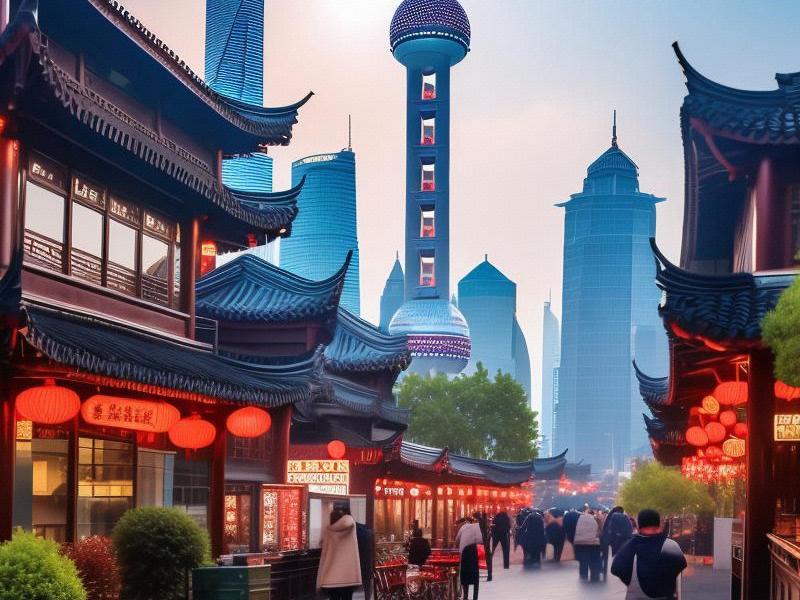This article provides a detailed exploration of Shanghai's rich cultural heritage, culinary delights, and historical milestones. It aims to offer readers a comprehensive understanding of what makes Shanghai one of the most fascinating cities in China.

Shanghai, often referred to as the "Pearl of the Orient," is a vibrant metropolis that seamlessly blends tradition with modernity. Its unique blend of cultures, exquisite cuisine, and profound historical significance make it a must-visit destination for travelers from around the world.
I. Shanghai's Cultural Heritage
Shanghai's cultural heritage is a tapestry woven from diverse threads, reflecting its status as a global trade hub for centuries. The city's history is marked by the convergence of Chinese and Western influences, resulting in a distinctive cultural identity.
The Bund, a historic waterfront area, stands as a testament to Shanghai's colonial past. Once lined with grandiose buildings of European architecture, the Bund offers a glimpse into the city's former glory as a major trading port. Today, it serves as a popular tourist attraction, where visitors can stroll along the promenade, admire the stunning skyline, and take in the views of the Huangpu River.
In contrast, the Old City of Shanghai, also known as Nanshi, showcases the city's rich Chinese heritage. This area is characterized by narrow lanes, traditional Chinese architecture, and bustling markets. Visitors can explore ancient temples, such as the Longhua Temple, and experience the authentic charm of old Shanghai.
Shanghai's cultural scene is also enriched by its vibrant arts and entertainment. The city boasts numerous art galleries, theaters, and music venues that showcase a wide range of artistic expressions. From traditional Chinese opera to contemporary art exhibitions, Shanghai offers something for every taste.
上海贵族宝贝自荐419 Moreover, Shanghai is home to several world-renowned universities and research institutions, attracting scholars and students from all over the world. This intellectual hub has contributed to the city's reputation as a center of culture, innovation, and creativity.
II. Shanghai's Culinary Delights
Shanghai cuisine, known as "Hu Cai" in Mandarin, is one of the eight major culinary traditions of China. It is characterized by its delicate flavors, exquisite presentation, and use of fresh ingredients.
One of the most iconic dishes in Shanghai cuisine is Xiaolongbao, or soup dumplings. These bite-sized dumplings are filled with juicy pork and broth, and are typically served steaming hot. The art of making Xiaolongbao lies in the precise control of the dough and filling, ensuring that each dumpling bursts with flavor upon咬破 (popping open - breaking the skin to release the juice) (breaking the skin to release the juice).
Another popular dish is Shengjianbao, or pan-fried dumplings. These dumplings are made with a thin wrapper and filled with minced pork and chives. They are pan-fried until the bottom is crispy and golden brown, while the top remains soft and fluffy.
Shanghai's culinary scene also offers a wide range of other dishes, such as Lion's Head Meatballs, which are large, juicy meatballs cooked in a savory sauce; Sweet and Sour Mandarin Fish, a dish that combines the sweetness of pineapple juice with the tanginess of vinegar; and Braised Pork Belly, a rich and flavorful dish that is slow-cooked until tender.
上海夜网论坛
In addition to traditional Chinese cuisine, Shanghai also boasts a diverse array of international restaurants. From Italian pasta to Japanese sushi, the city offers something for every palate. This culinary diversity reflects Shanghai's status as a global city that embraces different cultures and influences.
III. Shanghai's Historical Milestones
Shanghai's history dates back thousands of years, but it was during the 19th century that the city began to emerge as a major global power. In 1842, following the First Opium War, China ceded Hong Kong to Britain and opened up five treaty ports, including Shanghai, to foreign trade.
This marked the beginning of Shanghai's transformation into a cosmopolitan city. Foreign powers established concessions in the city, bringing with them their own cultures, architectures, and businesses. This period of rapid development saw the construction of iconic landmarks such as the Bund, the Peace Hotel, and the Shanghai Club.
During the early 20th century, Shanghai became known as the "Paris of the East," a nickname that reflected its vibrant nightlife, fashionable trends, and cultural diversity. The city was a haven for artists, writers, and intellectuals, who flocked to Shanghai to escape the political turmoil in other parts of China.
上海喝茶服务vx However, Shanghai's prosperity was short-lived. In 1949, the Communist Party of China took control of the city, marking the beginning of a new era. During the following decades, Shanghai underwent significant changes, including the closure of its foreign concessions and the implementation of socialist policies.
In recent decades, Shanghai has experienced rapid economic growth and urbanization. The city has transformed into a global financial hub, with towering skyscrapers, modern infrastructure, and a thriving business environment. At the same time, Shanghai has also made efforts to preserve its cultural heritage and historical landmarks, ensuring that the city's rich history is not forgotten.
IV. Conclusion
Shanghai is a city that truly embodies the saying "a blend of East and West." Its unique cultural heritage, exquisite cuisine, and profound historical significance make it a fascinating destination for travelers from all over the world.
Visiting Shanghai offers a chance to immerse oneself in the city's vibrant culture, savor its delicious cuisine, and explore its rich history. Whether it's strolling along the Bund, exploring the Old City, or indulging in a meal of Shanghai's famous dishes, visitors are sure to leave with unforgettable memories.
As Shanghai continues to grow and evolve, it remains a symbol of China's openness to the world and its commitment to preserving its rich cultural heritage. The city's story is one of resilience, innovation, and creativity, and it serves as an inspiration for cities around the globe.
In conclusion, Shanghai's culture, cuisine, and history are integral parts of its identity and charm. By exploring these aspects, we can gain a deeper understanding of this remarkable city and appreciate its unique place in the world.